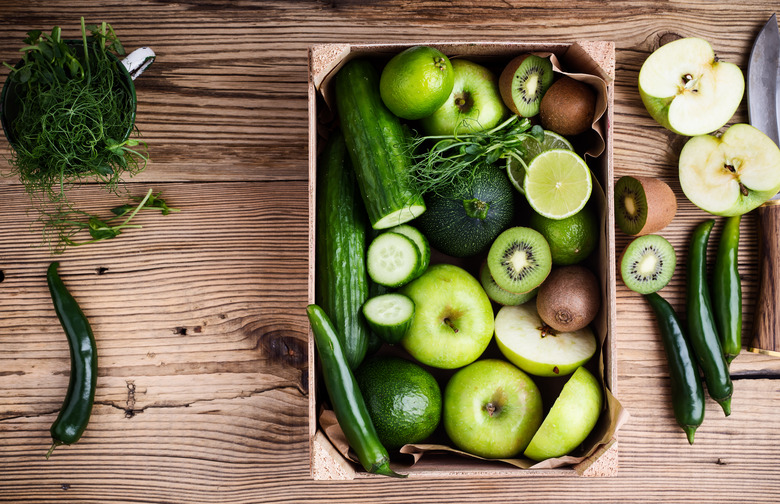What Is The Difference Between A Fruit & A Vegetable?
A fruit, botanically speaking, is a seed-bearing structure. It develops originally from what is called the ovary of its flowering mother plant and includes stone fruits such as peaches, nectarines and plums as well as apples, berries, pears and even bananas. Vegetables, botanically speaking, are the roots, leaves and even stems of a plant.
So, why is a tomato considered a vegetable? The tomato is one food item that is so often misrepresented as a vegetable that it is simply and legally considered a vegetable even though it's a fruit genetically. Confused? There are a few ways to dissect this whole fruit/vegetable dilemma and get down to the dirt basics of the difference between a fruit and a vegetable.
- A fruit, botanically speaking, is a seed-bearing structure.
- The tomato is one food item that is so often misrepresented as a vegetable that it is simply and legally considered a vegetable even though it's a fruit genetically.
Fruit vs. Vegetable
Is an apple a fruit or vegetable? Is an avocado a vegetable or fruit? There is one scientific way to answer the fruit vs. vegetable question.
Gardeners define fruits and vegetables differently than the home chef. A gardener will correctly classify a fruit by how it is grown. If it comes from a flowering mother plant's branches, then it is a fruit, and if it is part of the actual plant, then it is a vegetable.
A chef will call eggplants, bell peppers and tomatoes vegetables because they are often used in savory dishes. However, since they grow from a flowering plant, they are botanically considered a fruit. The savory fruits have long been considered vegetables.
- Is an apple a fruit or vegetable?
- A chef will call eggplants, bell peppers and tomatoes vegetables because they are often used in savory dishes.
History of the Debate
The fruit vs. vegetable debate has a long history. The confusion about what is a fruit and what is a vegetable can be traced back to a money issue: taxes, to be specific.
In 1893, the court ruled in the case of Nix v. Hedden that a tomato that crossed into United States soil should be taxed as a vegetable. Why did this red, round food need the United States Supreme Court to make a judgment on its classification? If it had been considered a fruit, then it would have had a lower tax levied on its ripe goodness.
While the court did recognize that the tomato is a fruit botanically speaking, its main use was in the form of a savory dish in the kitchen. Chefs considered the tomato a vegetable, so the Supreme Court thought so too. So, technically, ketchup made from tomatoes is considered a vegetable, which the state of New Jersey decided in a bill presented in its 2005 legislative session.
- The fruit vs. vegetable debate has a long history.
- While the court did recognize that the tomato is a fruit botanically speaking, its main use was in the form of a savory dish in the kitchen.
The Avocado Issue
The soft, gentle, green flesh of the avocado surrounds a solid seed as big as a golf ball. This should clearly classify it as a fruit. However, it is often associated with its grocery store counterparts that are considered vegetables. The fleshy pulp is used in salads, side dishes and smoothies, making it one of the more versatile fruits that masquerade as a vegetable when placed on the dinner table.
The California Avocado Commission is hoping more people realize the possibilities of the pale green flesh as a fruit. It recently announced that the avocado is actually a berry – botanically speaking, of course.
Potato and Other Roots
Fried, baked, sautéed or boiled, the potato is one of the most well-known and consumed vegetables, although it is actually a stem. The starchy tuber grows from short branches that are called stolons. The stolons are attached to the leafy green plant above the surface.
- The soft, gentle, green flesh of the avocado surrounds a solid seed as big as a golf ball.
- The California Avocado Commission is hoping more people realize the possibilities of the pale green flesh as a fruit.
Roots are edible plants that grow underground. They have a leafy top, often thin and willowy to soak up sun and nutrients to feed to its bulbous roots that grow so well below the garden. Root vegetables include onions, carrots, sweet potatoes, turnips, radishes and beets.
Surprising Vegetables and Fruits
Ginger, turmeric, garlic and fennel are often used as spices in savory dishes. However, the flowering plants' bulbous roots are classified as vegetables and can be made into a wide variety of edible treats. These can be used sliced thinly in meat dishes, mashed and served on the side and put into savory smoothies and soups. These root vegetables are chock full of antioxidants.
- Roots are edible plants that grow underground.
- However, the flowering plants' bulbous roots are classified as vegetables and can be made into a wide variety of edible treats.
Other fruits often mistaken as vegetables include:
- Olives
- Pumpkins
- Cucumbers
- Squash
- Bell Peppers
- Okra
